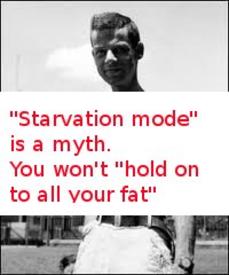Welcome to Debate Club! Please be aware that this is a space for respectful debate, and that your ideas will be challenged here. Please remember to critique the argument, not the author.
How good are TDEE / BMR estimators?

EvgeniZyntx
Posts: 24,208 Member
Not that good, especially if you are obese. This suggests we use them as an initial guideline then work from the experience of weight loss week to week.
Clin Nutr. 2013 Dec;32(6):976-82. doi: 10.1016/j.clnu.2013.03.022. Epub 2013 Apr 11.
Bias and accuracy of resting metabolic rate equations in non-obese and obese adults.
Frankenfield DC1.
BACKGROUND & AIMS:
Consensus on the best equation for predicting metabolic rate in healthy people remains elusive. New equations continue to appear. The purpose of the current study was to validate several standard and new metabolic rate equations in obese and non-obese adults.
METHODS:
Resting metabolic rate was measured with indirect calorimetry and calculated using the Mifflin St. Jeor, Livingston, Harris Benedict, Muller, Vander Weg, WHO equations, and the Oxford variation of WHO. Each equation was compared for accuracy (percent of estimates falling within 10% of measured) and bias (95% confidence intervals of differences between estimate and measured expenditure that excluded zero).
RESULTS:
Three hundred thirty-seven ambulatory, community-living adults were measured. The Mifflin St. Jeor equation was unbiased (95% confidence interval -26 to +8 kcal/day), the Livingston equation tended to underestimate true metabolic rate (95% confidence interval -63 to -25 kcal/day), while all other equations tended to overestimate true metabolic rate. Accuracy rate was similar between Mifflin St. Jeor and Livingston (82 vs. 79%). Accuracy rate was lower in obese than non-obese volunteers, no matter which equation was used (for example 87 vs. 75% for the Mifflin St. Jeor equation).
CONCLUSION:
The Mifflin St. Jeor equation is confirmed as a useful prediction equation for resting metabolic rate in community-living ambulatory adults of various body sizes, though the Livingston equation is similar. Accuracy rate is lower in obese than non-obese people, and so an obesity-specific equation is proposed. This equation needs validation before it is adopted for clinical use.
0
Replies
-
I think the ones that purely use body weight are the worst for obese people. Something related to lean body mass has a better chance.
It's always amusing to see people using 4 significant figures for BMR when only ~70% of the population fall within 10% of the estimate.0 -
I read a bunch about them when I started, and definitely realized that without the body fat percentage (which most aren't going to know) the BMR/TDEE estimate was likely overstated. I ran a few options with estimated body fat to get a good since of the likely range and how it differed, and that's one (of a few) reasons why I think obese people should be fine with starting with a more aggressive goal (and not a super unaggressive one unless there are specific reasons for that), as chances are it's overstating your TDEE.
Of course, after all that I consistently lost more than predicted when I was obese, but I think it's because I was more active than I'd realized.0 -
The Ketch McArdle equation, which uses body fat, is reported as being more accurate but I've yet to dig out a study on it.0
-
I hope you find one.
The drawback, of course, is that most don't know their real BF%.1 -
EvgeniZyntx wrote: »The Ketch McArdle equation, which uses body fat, is reported as being more accurate but I've yet to dig out a study on it.
Watch the spelling - Katch McArdle http://www.calculatorpro.com/calculator/katch-mcardle-bmr-calculator/
Gender neutral and uses lean body mass alone attributing no metabolic requirement to fat
BMR (kcal/day) = 370 + 21.6*LBM (kg) = 370 + 9.8*LBM (lbs)
Not found a paper yet either, perhaps it's in their book. Seems that correlation coefficients of ~0.67 are viewed as good in this field.
BMI of ~50 - "The Harris-Benedict with actual body weight and WHO equations were less accurate on individual terms, with 29% and 42% of the predicted REE values, respectively, falling outside +/-10% of IC REE" http://www.ncbi.nlm.nih.gov/pubmed/174631480 -
Even that amount of accuracy can be easily undone by inaccurate food logging when trying to use them for practical rather than academic purposes.
Trial & error plus adjusting goal based on results over time FTW.0 -
http://ajcn.nutrition.org/content/88/4/959.full concluded "For overweight and obese Dutch adults, there appears to be no accurate equation."0
This discussion has been closed.
Categories
- All Categories
- 1.4M Health, Wellness and Goals
- 398.2K Introduce Yourself
- 44.7K Getting Started
- 261K Health and Weight Loss
- 176.4K Food and Nutrition
- 47.7K Recipes
- 233K Fitness and Exercise
- 462 Sleep, Mindfulness and Overall Wellness
- 6.5K Goal: Maintaining Weight
- 8.7K Goal: Gaining Weight and Body Building
- 153.5K Motivation and Support
- 8.4K Challenges
- 1.4K Debate Club
- 96.5K Chit-Chat
- 2.6K Fun and Games
- 4.8K MyFitnessPal Information
- 12 News and Announcements
- 21 MyFitnessPal Academy
- 1.5K Feature Suggestions and Ideas
- 3.2K MyFitnessPal Tech Support Questions


